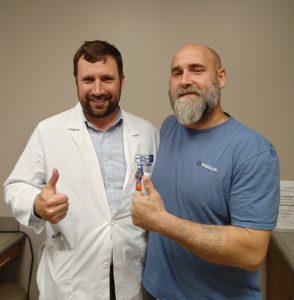According to the National Cancer Institute, the rate of colorectal cancer among adults younger than 50 has steadily risen over the last three decades.
In July 2021, John Chisholm, then 39, had no idea.
“It never crossed my mind that I’d have cancer at all,” John says.
Last summer, John and his wife, Yvette, couldn’t have guessed he would join that growing statistic. Persistent stomach issues plagued the home contractor to the point where he made appointments with a dietician and gastroenterologist.
A colonoscopy was scheduled as John’s symptoms quickly worsened. When the results came back, the couple heard something they never expected: John had a mass that was described as most likely being cancer.
“That kind of rocked our world,” Yvette recalls.
“It sucked the life right out of me because I thought I was Superman,” John adds.
He describes the first moments after the official diagnosis as a bad dream, one that he expected to wake up from. Now, with a stage 3 rectal cancer diagnosis, the couple had a slew of decisions to make. The first was where John would receive his cancer treatment. It ended up being an easy choice for the pair, opting to travel to Mary Bird Perkins Cancer Center in Baton Rouge after assessing the level of care in their hometown of McComb, Mississippi.
“This is always our place to go,” John says. “We don’t mind driving here. What’s the value of your life? A gallon of gas?”
“You could tell that these doctors were kind of moving mountains to help us right away,” Yvette says.
The delays and red tape they expected to face were nowhere to be found at the Cancer Center. Instead, they were blown away by the collaborative approach LaVie took with his colleagues to determine the best course of action.
“Mary Bird is very active in multi-disciplinary treatment boards with surgical oncologists, colorectal surgeons, radiation oncologists and medical oncologists,” says Dr. LaVie. “You have a lot of smart people in the room, and amongst smart people, you can have differences of opinions. What we strive for is consensus.”
In a matter of days, John was undergoing treatment, which consisted of chemo pills twice a day and four weeks of daily radiation at the Cancer Center’s Hammond location with Dr. Gregory Henkelmann, M.D., radiation oncologist, Mary Bird Perkins Cancer Center.
Hurricane Ida would force John to take some of his treatment at the Baton Rouge center. Regardless of location, the lines of communication with Drs. Henkelmann and LaVie remained open.
Multiple rounds of additional chemotherapy followed. Then it was time for new scans, which showed what is called a complete clinical response. According to LaVie, that is when there is no visibly detectable evidence of cancerous tumors. That type of response is good news, for sure, but not the whole ballgame.
“Just because you can’t see it on a scan, doesn’t mean there’s not a microscopic cancer cell,” Dr. LaVie explains.
That’s why the next step in treatment is typically surgery. However, Dr. LaVie says growing data shows some patients who achieve a complete clinical response may choose to be closely monitored by their oncologist in lieu of immediate surgery.
Regardless, John opted for surgery, a move LaVie agreed with. At a follow-up appointment in May 2022, John recalls Dr. LaVie throwing his hands up in celebration. The surgery brought with it confirmation that there was zero cancer remaining. In addition to a complete clinical response, John had a complete pathological response – arguably the best possible outcome, but one not all that common.
“I wish we saw it more,” Dr. LaVie says. “I see a few patients a year with that response.”
The burly patient was brought to tears, embracing LaVie in one of many giant bear hugs.
“What I had envisioned was something along the lines of, ‘we got it stable and we’ll be able to give you a better quality of life for the next few years,’” John says. “I never imagined they were going to tell me it was completely gone.”
Now back to his routine, John tells everyone about the Cancer Center and the personal relationships he’s formed with his team of doctors. The time and one-on-one focus they invested in his case, he says, was something he only got once he arrived at Mary Bird Perkins.
That individualized approach is something Dr. LaVie believes is important in the doctor-patient relationship.
“You have to step back and really get in the patient’s shoes because their reactions to a diagnosis are very different,” LaVie says.
Placing an emphasis on getting to know a patient’s social and emotional situation, Dr. LaVie says, allows him to better prepare them for their specific treatment, when additional physical stressors are likely to surface.
“I try to lay out what the next number of months will look like,” Dr. LaVie explains. “That way patients know what to expect and aren’t caught off guard.”
That personalized plan of care, John says, comes as a comfort during a cancer journey. For him, Mary Bird Perkins’ mission to improve survivorship and lessen the burden of cancer through expert treatment and compassionate care is evident from the front desk to exam rooms, to the state-of-the-art infusion center.
“Once we left Mary Bird Perkins for the first time, we felt like these people were going to help us,” John recalls. “Where we will get the best help that we can get. That made all the difference in the world.”

